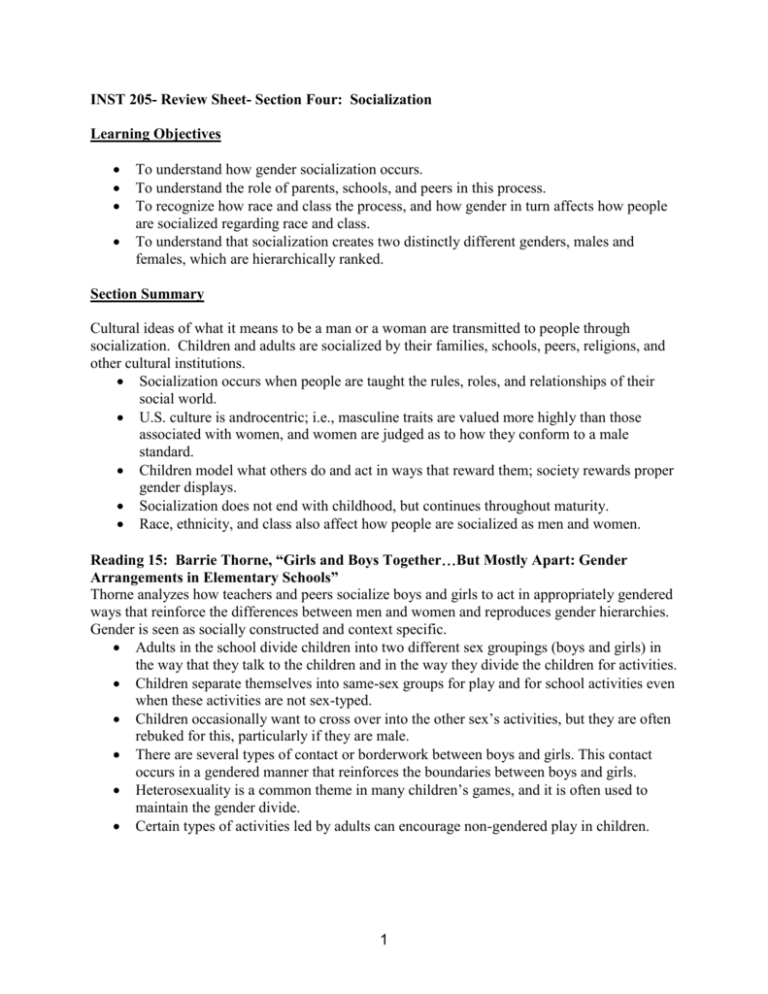
INST 205- Review Sheet- Section Four: Socialization
Learning Objectives
To understand how gender socialization occurs.
To understand the role of parents, schools, and peers in this process.
To recognize how race and class the process, and how gender in turn affects how people
are socialized regarding race and class.
To understand that socialization creates two distinctly different genders, males and
females, which are hierarchically ranked.
Section Summary
Cultural ideas of what it means to be a man or a woman are transmitted to people through
socialization. Children and adults are socialized by their families, schools, peers, religions, and
other cultural institutions.
Socialization occurs when people are taught the rules, roles, and relationships of their
social world.
U.S. culture is androcentric; i.e., masculine traits are valued more highly than those
associated with women, and women are judged as to how they conform to a male
standard.
Children model what others do and act in ways that reward them; society rewards proper
gender displays.
Socialization does not end with childhood, but continues throughout maturity.
Race, ethnicity, and class also affect how people are socialized as men and women.
Reading 15: Barrie Thorne, “Girls and Boys TogetherBut Mostly Apart: Gender
Arrangements in Elementary Schools”
Thorne analyzes how teachers and peers socialize boys and girls to act in appropriately gendered
ways that reinforce the differences between men and women and reproduces gender hierarchies.
Gender is seen as socially constructed and context specific.
Adults in the school divide children into two different sex groupings (boys and girls) in
the way that they talk to the children and in the way they divide the children for activities.
Children separate themselves into same-sex groups for play and for school activities even
when these activities are not sex-typed.
Children occasionally want to cross over into the other sex’s activities, but they are often
rebuked for this, particularly if they are male.
There are several types of contact or borderwork between boys and girls. This contact
occurs in a gendered manner that reinforces the boundaries between boys and girls.
Heterosexuality is a common theme in many children’s games, and it is often used to
maintain the gender divide.
Certain types of activities led by adults can encourage non-gendered play in children.
1
Boxed Insert: AAUW, “Hostile Hallways”
This box presents the results of an Association of American University Women survey on sexual
harassment in schools. The vast majority (81%) of male and female American 8th through 11th
graders experience sexual harassment in school usually beginning in junior high/middle school.
Girls are slightly more likely than boys to be subjected to sexual harassment, and girls
face this harassment more frequently.
Students experience various forms of sexual harassment with sexual comments, jokes,
gestures, and looks being the most common.
Less than 20% of students who were sexually harassed were harassed by school
employees. Most of those who have been harassed were harassed by students.
Students rarely report harassment to adults, but they are likely to tell their peers.
Sexual harassment has important consequences for children’s grades and their feelings
towards school. There are also emotional consequences like embarrassment and feeling
self-conscious and behavioral consequences such as avoiding the harasser(s) and
avoiding particular school locations or activities.
Girls, especially African American girls, report greater problems from harassment.
One of the worst types of harassment students faced was being called gay or lesbian,
though the majority of those who faced this harassment have called someone else gay.
Reading 16: Michael Kimmel, “What Are Little Boys Made Of?”
The debate over why boys have startling rates of depression, suicide, and attention deficit
disorder, as well as why boys are so violent, has been a debate over proper gender socialization.
While many claim that feminists have denied the true nature of boys, Kimmel suggests that
feminism provides the best way to help boys through these “crises.”
One side of the debate suggests that there are biological (primarily hormonal) reasons for
the “natural” male behavior of violence. Biological determinism ignores the differences
between boys and overstates how girls and boys differ biologically.
Some therapists have written that boys should be allowed to express their emotions in
ways other than through false posturing and violence, but these books primarily address
white middle- to upper-class boys.
The best books that address these problems highlight male privilege and the need to
address its effects. These books address both the emotional aspect and the privilege that
males learn.
Kimmel suggests the real boy crisis is about violence. Boys learn violence because they
are praised for it, not because they are biologically prone to be violent.
Reading 17: Yen Le Espiritu, “‘We Don’t Sleep Around Like White Girls Do’: Family,
Culture, and Gender in Filipina American Lives”
Espiritu’s interviews with nearly one hundred Filipino Americans explores how gender factors
into minority understandings of whiteness and their own cultural identity. Filipino immigrant
families assert cultural superiority over the dominant group (white Americans) by asserting that
their daughters have higher moral standards regarding sexuality and commitment to the family.
To most Filipinos, “American” meant white.
The Filipino immigrants claim power denied to them by racism through gendered
constructions of their daughters as virtuous and white women as sexually immoral.
2
Historically, Filipinos and other Asian women have been characterized as erotic or as
submissive by white American culture. Filipinos are aware of the hypersexualization of
Filipino women and have been careful to separate themselves from this.
Filipino families tend to restrict their daughters’ autonomy, mobility, and personal
decision making in order to “defend” their cultural superiority.
Sons are allowed significantly more freedom than daughters. Daughters are expected to
have careers but also to fulfill traditional roles as women by marrying and birthing and
caring for children.
Filipinos also felt their culture was superior to white American culture because their lives
revolved around their close-knit families and white families were seen as impersonal or
individualistic. The responsibility for maintaining family ties and cultural traditions
rested with Filipino women, as it often falls on women of all cultures.
Enforcing sexual and familial responsibility reinforces patriarchy among Filipinos.
Nearly all cultures conflate “proper” femininity with sexual passivity. When Filipinas
break out of this chastity mold, they are seen as betraying their culture and are often
denied an “authentic Filipino” identity. Parental restrictions cause many serious reactions
in Filipino girls like running away or committing suicide.
Many of the women came to understand what it meant to be black when they began
exclusively dating African American men.
When they identified as black, the women no longer felt completely comfortable around
whites, including their own families.
Discussion Questions
Reading 15: Barrie Thorne, “Girls and Boys TogetherBut Mostly Apart: Gender
Arrangements in Elementary Schools”
1.
2.
3.
How were the ways boys and girls played shown to be different in Thorne’s study? How
did this work at your school?
How might the gender socialization children learn through school and through play enforce
gendered ideas for these people’s later behavior?
How can adults encourage mixed play between boys and girls? Why might this be
important?
Boxed Insert: AAUW, “Hostile Hallways”
4.
5.
6.
Is it just girls who are being sexually harassed in schools? What are some differences
between the harassment of boys and girls? Are there racial differences in who gets
harassed?
According to the AAUW survey what types of harassment do 8th through 11th graders face?
What is the most common type? What types of sexual harassment did you face in school?
How do children respond to sexual harassment? Who do they tell? What consequences does
the harassment have on their education? Their emotional health? Their other behaviors?
3
Reading 16: Michael Kimmel, “What Are Little Boys Made Of?”
What is the “boy crisis?” Is this a real crisis? Is it new?
Why do some people claim that feminism is to blame for boys’ violent behavior? What do
you think feminism’s role is in the boy crisis?
9. According to Kimmel, what are the benefits of feminism in handling the “boy crisis”? Do
you agree?
10. Kimmel discusses violent boys, but girls are sometimes violent as well. How are the
processes that cause boys to be violent different from the processes that cause girls to be
violent?
7.
8.
Reading 17: Yen Le Espiritu, “‘We Don’t Sleep Around Like White Girls Do’: Family,
Culture, and Gender in Filipina American Lives”
11. How do Filipinos see white Americans? How do Filipinos view their own culture? Do you
think these are accurate pictures of whites and Filipinos?
12. Yen Le Espiritu suggests that these negative perceptions of white culture allow Filipinos to
“assert superiority” over whites. How might this perception of differences between whites
and Filipinos help Filipinos to combat racism? What are the problems with this way of
thinking?
13. What stereotypes of Filipinas and other Asian women exist in white culture? Do you think
these stereotypes factor into the Filipino focus on sexual morality?
14. How do Filipinos treat their male and female children differently? What consequences does
this have for the daughters? How might this maintain patriarchy?
Feminist.Com: Links on Parenting and the Family
Michael Kimmel suggests that “the boy crisis” suggests a need for feminist parenting. This
webpage offers a variety of links to websites that provide information on parenting and families
from a feminist perspective.
http://www.feminist.com/resources/links/links_fam.html
Gender at Work
Gender socialization is achieved through a variety of cultural institutions and practices. Major
international organizations (including the United Nations’ Fund for Women) are working
together to change traditional gender norms, values, practices, and systems of power through
Gender at Work. This website provides links to articles and ideas on gender roles throughout the
world and how they are changing.
http://www.genderatwork.org/index.php
Information on Sexual Harassment
Nancy Wyatt, a professor at Penn State University, offers detailed information on sexual
harassment including sexual harassment in schools. There are links to additional readings on this
topic as well as scenarios to help individuals and families.
http://www.de2.psu.edu/harassment/
4
National Commission on the Role of Filipino Women
Yen Le Espiritu describes one aspect of the gender socialization of Filipino-American girls. The
National Commission on the Role of Filipino Women is an organization in the Philippines that
works for the advancement of Filipino women and for gender equality in Filipino society. This
website focuses on the role of gender in Filipino’s lives and provided links to detailed reports on
Filipino women’s lives.
http://www.ncrfw.gov.ph/index.asp
Supporting Our Sons
In recent years, scholars, teachers, and parents have been paying more attention to how to raise
psychologically healthy boys. This is the website of an organization devoted to this mission.
http://www.supportingoursons.org/index.html
The U.S. Equal Employment Opportunity Commission: Facts about Sexual Harassment
This webpage provides additional information on sexual harassment from a legal standpoint. The
U.S. Equal Employment Opportunity Commission monitors sexual harassment in the workplace.
This page provides links to additional information including the Civil Rights Act that outlawed
sexual harassment and details on how to file a sexual harassment claim.
http://www.eeoc.gov/facts/fs-sex.html
5










